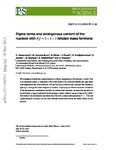Sigma terms and strangeness content of the nucleon with Nf=2+1+1 twisted mass fermions
| dc.contributor.author | Drach, V | |
| dc.contributor.author | Alexandrou, C | |
| dc.contributor.author | Constantinou, M | |
| dc.contributor.author | Dinter, S | |
| dc.contributor.author | Hadjiyiannakou, K | |
| dc.contributor.author | Jansen, K | |
| dc.contributor.author | Koutsou, G | |
| dc.contributor.author | Vaquero, A | |
| dc.contributor.author | Strelchenko, A | |
| dc.date.accessioned | 2018-05-08T08:46:19Z | |
| dc.date.available | 2018-05-08T08:46:19Z | |
| dc.date.issued | 2012-12-20 | |
| dc.identifier.issn | 1824-8039 | |
| dc.identifier.uri | http://hdl.handle.net/10026.1/11406 | |
| dc.description | 7 pages, 6 figures. Talk given at the XXX International Symposium on Lattice Field Theory - Lattice 2012, June 24-29, 2012 Cairns, Australia | |
| dc.description.abstract |
We investigate excited state contaminations in a direct computation of the nucleon s-terms. This is an important source of systematic effects that needs to be controlled besides the light quark mass dependence and lattice artefacts. We use maximally twisted mass fermions with dynamical light (u,d), strange and charm degrees of freedom. Employing an efficient stochastic evaluation of the disconnected contribution available for twisted mass fermions, we show that the effect of excited states is large in particular for the strange s-terms, where it can be as big as O(and 40%). This leads to the unfortunate conclusion that even with a source-sink separation of -1.5 fm and a good statistical accuracy it is not clear, whether excited state effects are under control for this quantity. | |
| dc.format.extent | 163- | |
| dc.language.iso | en | |
| dc.publisher | Sissa Medialab | |
| dc.subject | hep-lat | |
| dc.subject | hep-lat | |
| dc.title | Sigma terms and strangeness content of the nucleon with Nf=2+1+1 twisted mass fermions | |
| dc.type | conference | |
| dc.type | Conference Proceeding | |
| plymouth.author-url | http://arxiv.org/abs/1211.4447v1 | |
| plymouth.date-start | 2012-06-24 | |
| plymouth.volume | Part F130497 | |
| plymouth.conference-name | The 30th International Symposium on Lattice Field Theory | |
| plymouth.publication-status | Published | |
| plymouth.journal | Proceedings of The 30th International Symposium on Lattice Field Theory — PoS(Lattice 2012) | |
| dc.identifier.doi | 10.22323/1.164.0163 | |
| plymouth.organisational-group | /Plymouth | |
| plymouth.organisational-group | /Plymouth/Faculty of Science and Engineering | |
| plymouth.organisational-group | /Plymouth/REF 2021 Researchers by UoA | |
| plymouth.organisational-group | /Plymouth/REF 2021 Researchers by UoA/EXTENDED UoA 10 - Mathematical Sciences | |
| plymouth.organisational-group | /Plymouth/REF 2021 Researchers by UoA/UoA10 Mathematical Sciences | |
| plymouth.organisational-group | /Plymouth/Users by role | |
| plymouth.organisational-group | /Plymouth/Users by role/Academics | |
| dc.identifier.eissn | 1824-8039 | |
| dc.rights.embargoperiod | Not known | |
| rioxxterms.versionofrecord | 10.22323/1.164.0163 | |
| rioxxterms.licenseref.uri | http://www.rioxx.net/licenses/all-rights-reserved | |
| rioxxterms.type | Conference Paper/Proceeding/Abstract |


